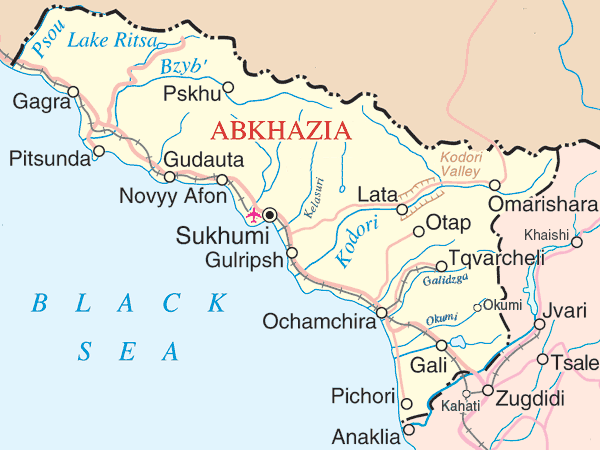Kelasuri Wall on:
[Wikipedia]
[Google]
[Amazon]
The Kelasuri Wall ( ka, კელასურის კედელი) or Great Abkhazian Wall ( ka, აფხაზეთის დიდი კედელი) is a stone wall located to the east of Sukhumi in
 The wall begins near the mouth of Kelasuri River where the ruins of a large tower remained. It goes to the east crossing
The wall begins near the mouth of Kelasuri River where the ruins of a large tower remained. It goes to the east crossing
Abkhazia
Abkhazia, ka, აფხაზეთი, tr, , xmf, აბჟუა, abzhua, or ( or ), officially the Republic of Abkhazia, is a partially recognised state in the South Caucasus, recognised by most countries as part of Georgia, which vi ...
, Georgia. The exact time of its construction is not known; several dates ranging from antiquity to the 17th century were suggested, although more recent works have provisionally favoured construction in the 6th century AD. The wall featured about 300 towers, most of them now entirely or largely ruined.
Location
 The wall begins near the mouth of Kelasuri River where the ruins of a large tower remained. It goes to the east crossing
The wall begins near the mouth of Kelasuri River where the ruins of a large tower remained. It goes to the east crossing Kodori River
The Kodori ( ka, კოდორი; ab, Кәыдры, Kwydry) is one of the two largest rivers of Abkhazia, along with the Bzyb. It is formed by the joining of the rivers Sakeni and Gvandra. The Kodori is first among Abkhazia's rivers with re ...
near Tsebelda fortress, then passes near Tkvarcheli
Tkvarcheli ( ka, ტყვარჩელი ; ab, Тҟəарчал, ''Tqwarchal''; Ткуарчал (Tkuarchal) russian: Ткварчели, ''Tkvarcheli'') is a town in Abkhazia. It is situated on the river Ghalidzga (Aaldzga) and a railway c ...
and terminates near the village of Lekukhona on the right bank of Enguri
The Enguri ( ka, ენგური, tr, xmf, ინგირი, ingiri, ab, Егры, ''Egry'' russian: Ингури, ''Inguri'') is a river in western Georgia. It is long, and has a drainage basin of .Embrasures were usually located in the towers' northern and western walls on the second floor.
, Материалы по археологии Абхазии. Тбилиси, 1967, с. 115-128 For example, the Swiss traveller Frédéric Dubois de Montpéreux (fr) asserted that the wall was built by Greeks in the last centuries BC to protect their colony of
History of construction
Since the wall was first examined scientifically in early 19th century, many hypotheses on who and when built it were published. История изучения средневековых памятников Абхазии, Материалы по археологии Абхазии. Тбилиси, 1967, с. 115-128 For example, the Swiss traveller Frédéric Dubois de Montpéreux (fr) asserted that the wall was built by Greeks in the last centuries BC to protect their colony of
Dioscurias
Sukhumi (russian: Суху́м(и), ) or Sokhumi ( ka, სოხუმი, ), also known by its Abkhaz name Aqwa ( ab, Аҟәа, ''Aqwa''), is a city in a wide bay on the Black Sea's eastern coast. It is both the capital and largest city of ...
(which he erroneously placed near the Kodori cape
According to Mikhail Ivashchenko, the wall was built by Byzantines in the 4th century to protect their possessions and control mountain passes. He connected the name of the river Kelasuri with Byzantine Greek ''kleisoura'', a Byzantine territorial unit smaller than a theme
Theme or themes may refer to:
* Theme (arts), the unifying subject or idea of the type of visual work
* Theme (Byzantine district), an administrative district in the Byzantine Empire governed by a Strategos
* Theme (computing), a custom graphical ...
. Several other historians supported this date although they could not agree on the length and orientation of the wall.
Yuri Voronov, a well-known Abkhazian historian and archaeologist, examined the Abkhazian wall in 1966-1971 and proposed a new date of its construction. According to Voronov, Prince of Mingrelia
Mingrelia ( ka, სამეგრელო, tr; xmf, სამარგალო, samargalo; ab, Агырны, Agirni) is a historic province in the western part of Georgia, formerly known as Odishi. It is primarily inhabited by the Mingrelian ...
, Levan II Dadiani built Kelasuri Walls between 1628 and 1653 to protect his fiefdom from the Abkhaz invasions (though at that time Principality of Abkhazia was a nominal vassal of Mingrelia). Per Voronov's work the embrasures in the wall were made for firearms; he also quoted Georgian historian Vakhushti and Italian missionary Arcangelo Lamberti who both wrote about the wall built by Megrelian princes for protection from the Abkhaz.Ю.Н. Воронов (''Yury Voronov''), "Келасурская стена" (''Kelasuri wall''). Советская археология 1973, 3.
References
{{Commons category, Kelasuri Wall Fortifications in Abkhazia Ruins in Georgia (country) Border barriers Fortification lines